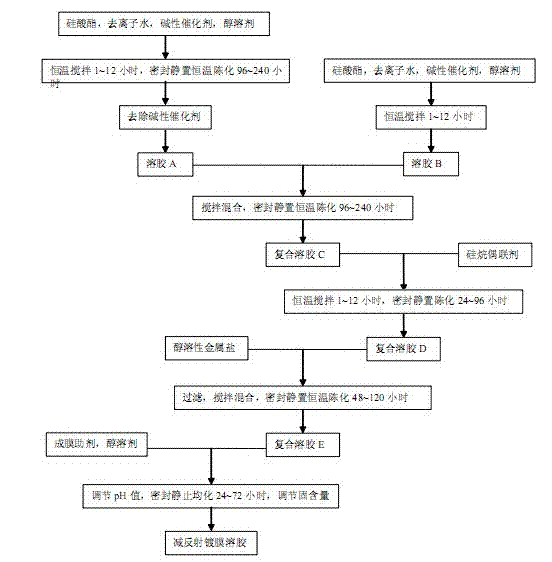Composite sol for anti-reflection coating and anti-reflection coated photovoltaic glass
A composite sol, photovoltaic glass technology, applied in the direction of colloid chemistry, colloid chemistry, coating, etc., to reduce surface roughness, improve strength and weather resistance, reduce R & D and production costs
- Summary
- Abstract
- Description
- Claims
- Application Information
AI Technical Summary
Problems solved by technology
Method used
Image
Examples
Embodiment 1
[0043] A composite sol for anti-reflection coating, prepared according to the following method from the following raw materials:
[0044] Step 1: Mix ethyl orthosilicate, ethanol, ammonia water, and water at a volume ratio of 1:10:0.2:0.15, place on a magnetic stirrer and stir at 300r / min, heat to 40°C for pre-reaction 8 Hour;
[0045] Step 2: The mixed solution in step 1 was sealed and aged for 120 hours, and sol A was obtained by back distillation to remove ammonia for 6 hours;
[0046] Step 3: Take another ethyl orthosilicate, ethanol, hydrochloric acid, and water as raw materials and mix them according to the volume ratio of 1:10:0.02:0.15. Stir and pre-react at 40°C and 300r / min for 6 hours to obtain Sol B ;
[0047] Step 4: Press sol A and sol B by SiO 2 The content is mixed evenly at a ratio of 1:0.65, sealed and aged at 40°C for 48 hours to obtain composite sol C;
[0048] Step 5: Add silane coupling agent KH-550 to composite sol C at a ratio of 0.8g / L, and stir ma...
Embodiment 2
[0054] A composite sol for anti-reflection coating, prepared according to the following method from the following raw materials:
[0055] Step 1: Mix ethyl orthosilicate, isopropanol, ammonia water and water at a volume ratio of 1:10:0.3:0.15, place on a magnetic stirrer and stir at 300r / min, heat to 40°C Reaction for 8 hours;
[0056] Step 2: Seal and age the mixed solution in Step 1 at 40° C. for 120 hours, and back-distill to remove ammonia for 6 hours to obtain Sol A;
[0057] Step 3: Take another ethyl orthosilicate, isopropanol, hydrochloric acid, and water as raw materials and mix them according to the volume ratio of 1:10:0.04:0.15, and pre-react at 40°C and 300r / min for 6 hours to obtain Sol B;
[0058] Step 4: Press sol A and sol B by SiO 2 The ratio of content 1:0.25 is mixed evenly, sealed and aged at 40°C for 48 hours to obtain composite sol C;
[0059] Step 5: Add silane coupling agent KH-550 to composite sol C at a ratio of 1.2 g / L, and hydrolyze at 40°C and...
Embodiment 3
[0065] Step 1: Mix ethyl orthosilicate, isopropanol, ammonia water and water at a volume ratio of 1:10:0.25:0.15, place on a magnetic stirrer and stir at 300r / min, heat to 40°C Reaction for 8 hours;
[0066] Step 2: Seal and age the mixed solution in Step 1 at 40°C for 120 hours, and back-distill to remove ammonia for 8 hours to obtain Sol A;
[0067] Step 3: Take another ethyl orthosilicate, isopropanol, hydrochloric acid, and water as raw materials and mix them according to the volume ratio of 1:10:0.04:0.15, and pre-react at 40°C and 300r / min for 6 hours to obtain Sol B;
[0068] Step 4: Press sol A and sol B by SiO 2 The content is mixed evenly at a ratio of 1:0.25, sealed and aged at 40°C for 48 hours to obtain composite sol C;
[0069]Step 5: Add silane coupling agent KH-570 to the composite sol C at a ratio of 1.5 g / L, and stir magnetically at 40°C and 300r / min until the hydrolysis is complete;
[0070] Step 6: Place the composite sol obtained in Step 5 for static a...
PUM
| Property | Measurement | Unit |
|---|---|---|
| Thickness | aaaaa | aaaaa |
| Graininess | aaaaa | aaaaa |
| Graininess | aaaaa | aaaaa |
Abstract
Description
Claims
Application Information
 Login to View More
Login to View More - R&D
- Intellectual Property
- Life Sciences
- Materials
- Tech Scout
- Unparalleled Data Quality
- Higher Quality Content
- 60% Fewer Hallucinations
Browse by: Latest US Patents, China's latest patents, Technical Efficacy Thesaurus, Application Domain, Technology Topic, Popular Technical Reports.
© 2025 PatSnap. All rights reserved.Legal|Privacy policy|Modern Slavery Act Transparency Statement|Sitemap|About US| Contact US: help@patsnap.com

